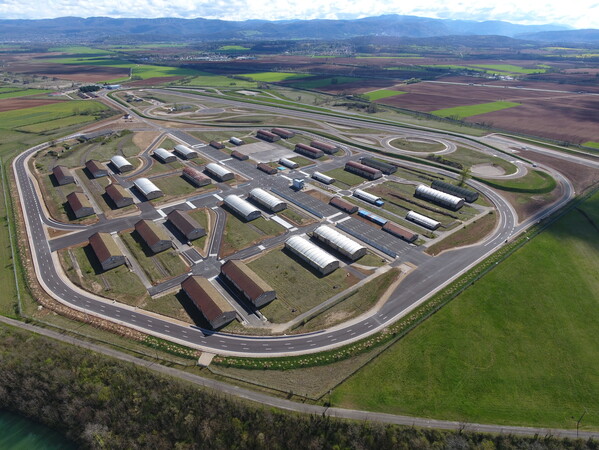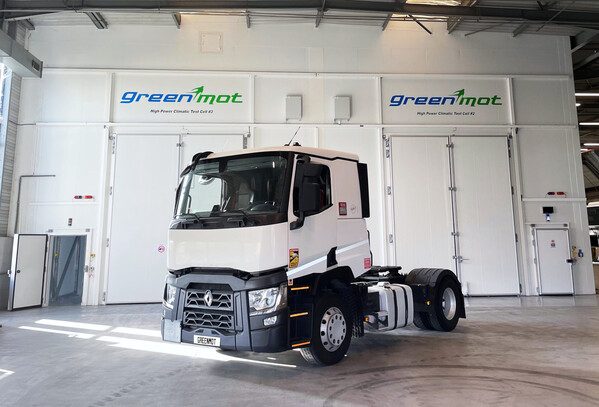Research and innovation for long-distance transport: the eRoadMontBlanc project is launched
An ambitious pilot project in the Auvergne-Rhône-Alpes region
The eRoadMontBlanc project, winner of France 2030's "Automated Road Mobility, Connected and Low-Carbon Service Infrastructure" call for projects, aims to propose a concrete solution for massive decarbona<on of road transport thanks to the Electric Road System (ERS).
The eRoadMontBlanc project is based on the APS system, which stands for Alimentation Par le Sol, or ground power supply.
This system was developed by Alstom for tramways and will be adapted for road use. It uses a power supply track inserted into the pavement and flush with the ground. The current is then collected under the vehicle by an articulated arm equipped with friction pads, which rest on the conductive segments. Identified by the Ministère de la Transition Écologique et de la Cohésion des Territoires in the study published in 2021, this technology changes the paradigm of electric transport by enabling vehicles to be powered and recharged while on the move.

An innovative concept offering a promising future for carbon-free mobility
Overall, the eRoadMontBlanc project aims to demonstrate the system's operational and technical feasibility, as well as its sustainability. The four-year project is divided into two phases:
- Phase 1 will lead to the creation of an operational demonstrator in 2024 on the TRANSPOLIS experimental platform in the Ain region (01). The tests will validate the technologies used and the safety of the system. At the same time, the Gustave Eiffel University will develop a digital twin to simulate the entire system, with the aim of optimizing the number of kilometers of infrastructure to be equipped to significantly reduce pollutant emissions.

- Phase 2 will transfer the experiment to the ATMB network by mid-2025. On 1 kilometer of the RN205 towards Chamonix and Italy, at the foot of Mont Blanc, full-scale tests will be carried out using this dynamic recharging principle. These tests are designed to meet freeway requirements in terms of safety, robustness and maintainability, particularly for winter maintenance.
Several vehicles will be used to demonstrate the possibilities offered by this solution: commercial vehicles, tractor-trailers and coaches. The heavy-duty vehicles will be supplied by GREENMOT, which will convert a 44-tonne truck and a coach into zero-emission vehicles, retrofitted from diesel to baSerie electric. Pronergy, for its part, will supply two electric commercial vehicles equipped with the electrical architecture adapted to current capture.
The many environmental benefits of the electric road (ERS)
The environmental benefits of this experiment are based on a number of factors. Firstly, the considerable reduction in greenhouse gas emissions compared with other energy carriers and technologies over the entire life cycle (diesel, CNG, battery electric only, etc.).
It also reduces the need to store energy transported by vehicles. The ERS makes it possible to better size the number and size of batteries on board vehicles, thus reducing the impact of metal resource extraction.
A continuous power supply solution also avoids the phenomenon of charge peaks during recharging times, which are generally short and occur during drivers' common breaks.
Last but not least, from the user's point of view, since vehicles are not required to stop to recharge at the network's electric charging points, they can continue on their way without any constraints, and complete their journeys in a timeframe comparable to current times.
100% French players committed to the development of electric mobility
The public-private consortium involved in this project mobilizes 100% French expertise and innovation. Alstom is contributing its expertise in rail electrification systems, while Gustave Eiffel University is sharing its experience in the research and development of innovative solutions for sustainable mobility. Expertise in on-board energy conversion systems is provided by Pronergy, while Greenmot is involved in the conversion of industrial and public vehicles. ATMB, the project sponsor, is providing its motorway network and the local knowledge of its teams for full-scale testing on a mountain freeway.
"The consortium partners are proud to be taking part in this ambitious initiative, and are convinced that charging technology via a ground power track will play a key role in the transition to more sustainable mobility."
Funded by the French government as part of France 2030 and by the European Union - Next Generation EU as part of the France Relance plan, the eRoadMontBlanc project marks an important step in the development of electric mobility in Europe. The eRoadMontBlanc project has also been recognized by the CARA and INDURA clusters.


